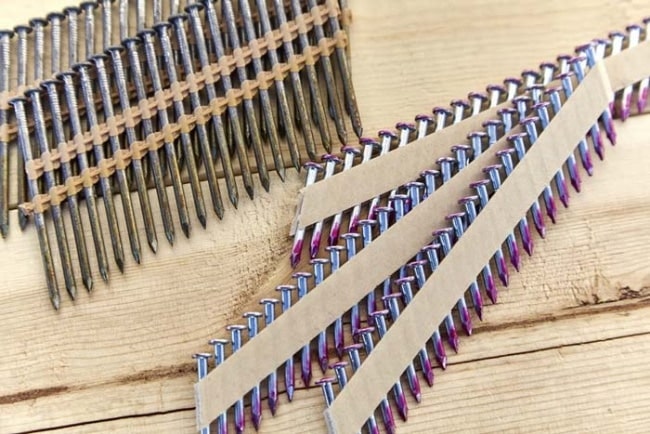The most popular nail guns are the framing nailers and the brad nailers. However, many individuals are unaware of their distinctions and are confused as to which applications they should perform.
The nail size is the most significant difference between the two tools.
As a result, they perform differently. While a brad nailer offers precise and clean woodworking results, the framing nailer is the best for heavy-duty construction.
This article will explain more about the characteristics of both tools. We also recommend some of their best applications.
Let’s read on to discover!
What Is A Brad Nailer?
A brad nailer is one of the most typical air-powered equipment in the woodworking shop. It can insert light gauge wiring brads into various woods without creating a big hole that is plugged.
Most brads range from 1/2 to 2 inches in length and have no or tiny heads. This feature enables them to go beyond the board’s surface, minimizing the need for a nail expected to start after.
While nailing, utilizing a nail with a tinier diameter can help to avoid fractured woods. Hence, you may apply the brad nailer in this case to have a precise result.
However, 18 gauge nails are insufficient to support high loads. It’s only suitable for thin wood boards and precise finishing.
What Is A Framing Nailer?
A framing nailer is a useful power tool for large-scale constructions. You need to consider tasks that involve hammering huge nails into hard material.
Professionals, for example, employ frame nailers mostly on house construction jobs.
A framing nailer is essential for constructing a house from the ground up or extending a room to an existing home.
Other massive construction jobs, such as the construction of a deck, also necessitate a framing nailer.
Framing nailers often work with nails ranging from 1-1/4 to 3-1/2 inches long. They offer adequate strength to link fences, 2x4s, and are excellent for fastening plaster without shattering.
Read more: How To Use A Framing Nailer?
Differences Between Brad Nailer Vs Framing Nailer
These two nailers have attributes that are similar to two distinct poles of the magnet.
Brad nailers are well-known for their delicate handiwork and intricate patterns. As a result, they’ve made it that way.
However, in terms of frame nailers, their endurance is significantly lower. A brad nailer is also much lighter than its competitor.
Size of nails
The size of the nails is the most significant concern in their differences. Framing nailers usually utilize more power than brad nailers due to the enormous size of the nails.
The bigger nail necessitates a higher degree of force to drive.
Framing nailers and brad nailers can’t be interchangeable. The fasteners and tools that each nailer uses have pretty different strengths.
This feature guarantees that you can use one tool to complete the responsibilities of the other.
Applications
With the different pressures applied, the tools perform specific tasks.
Some applications of a brad nailer are:
- Crown molding
- Trimming
- Cabinet-making
- Baseboard
- Woodcrafting
Framing nailers are in charge of heavy-duty tasks, such as:
- Deck construction
- House framing
- Basement construction
- Fence framing
- House construction
The differences between the two tools are quite clear. If you want to have a visual explanation, please access this video.
Pros And Cons Of Framing Nailer Vs. Brad Nailer
Each tool has its set of benefits and drawbacks. Let’s compare them on both sides to figure out which is better for you.
A brad nailer
This tool can offer precise results. Here are some critical points to take note of.
Pros
- A brad nailer is a temporary store item.
- This tool guarantees that all finishing work is exact and correct.
- It only leaves tiny holes that don’t need any putty filling.
- Using a brad nailer restricts the splitting of wood
- You have the option of working with a range of nail sizes.
- The nailer can operate efficiently and precisely in enclosed spaces
- Nails are strong and can carry a lot of weight.
Cons
- A brad nailer is not suitable for use on hard or thick wood.
A framing nailer
This tool is powerful. It has some outstanding features as follows:
Pros
- You have the option of working with a range of nail sizes.
- A framing nailer can operate efficiently and precisely in tighter areas.
- Nails are sturdy and can withstand a lot of weight.
Cons
- There may be varying frame nailer needs for various angled shots.
When To Use Each Nailer?
Both nailers are helpful for various purposes. The sort of task you’re performing and the type of wood you’ll be working with will determine the nailer you’ll need.
Moreover, the weight of the timber is an important aspect.
First and foremost, a brad nailer is necessary for the accurate and timely completion of jobs.
Crown molding, constructing cabinets, or providing more strength to current cabinets are the cases where a brad nailer works best. Besides, it can assist in installing baseboards on the floor.
Furthermore, you may use it to keep particular walls for appropriate gluing since you can remove brads after the glue has hardened.
On the other hand, the framing nailer comes in handy if you need to conduct more hard work. You can use them for high-volume, long-lasting woodwork.
It is capable of roofing, framing, deck and wood stair construction, and fence creation.
Frequently Asked Questions
Carpenters have shown their concerns towards the brad nailer and framing application. Here are some of their frequently asked questions. We hope that you can benefit from the answers to some extent.
Is it possible to frame with a brad nailer?
For framing walls, a brad nailer is ineffective. This tool lacks the necessary nail size and power to do the task effectively.
What makes a brad nailer different from a framing nailer?
The main difference is that brad nailers utilize 18 gauge nails, while frame nailers utilize angled nails of varying diameters.
As a result, they’re suitable for distinct purposes. You can’t get either of them in place of the other.
What are the applications of brad nailers?
Brad nailers are the best for baseboards, crown molding, cabinet construction, trimming work, and woodworking. They are not appropriate for use on thick and hardwood because of their small size nails.
What is the finest framing nail gun?
Framing nailers are the perfect nail gun for framing, as their names imply. A 30-degree framing nailer can offer you the best angle for reaching small areas and angles in framing situations.
Conclusion
We have shared with you a side-by-side comparison between a brad nailer vs. a framing nailer. They serve different purposes, so we can’t conclude which one is better.
It’s your requirement that determines the more suitable tool.
Hopefully, you will find this article helpful. If you need any further information, please feel free to ask. Thank you for reading!




